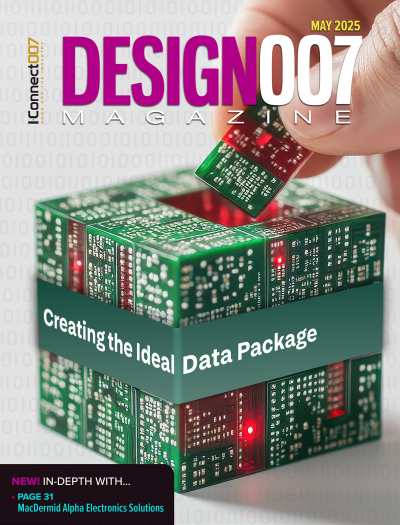-

-
News
News Highlights
- Books
Featured Books
- design007 Magazine
Latest Issues
Current Issue
Creating the Ideal Data Package
Why is it so difficult to create the ideal data package? Many of these simple errors can be alleviated by paying attention to detail—and knowing what issues to look out for. So, this month, our experts weigh in on the best practices for creating the ideal design data package for your design.

Designing Through the Noise
Our experts discuss the constantly evolving world of RF design, including the many tradeoffs, material considerations, and design tips and techniques that designers and design engineers need to know to succeed in this high-frequency realm.

Learning to Speak ‘Fab’
Our expert contributors clear up many of the miscommunication problems between PCB designers and their fab and assembly stakeholders. As you will see, a little extra planning early in the design cycle can go a long way toward maintaining open lines of communication with the fab and assembly folks.
- Articles
- Columns
Search Console
- Links
- Media kit
||| MENU - design007 Magazine
Beyond Design: The Case for Artificial Intelligence in EDA Tools
June 28, 2016 | Barry Olney, In-Circuit Design Pty LtdEstimated reading time: 2 minutes
I-Connect007 Editor Andy Shaughnessy reported that the keynote speaker at the IPC APEX EXPO Design Forum was Dean Parker, a former PCB designer at Shure who is now a CAD manager at Google X. Parker is involved in the development of autonomous vehicles and all sorts of other great ideas at Google X. According to Andy, Parker told the crowd, among other things, that EDA tool vendors need to trash all their old 1990s code and start over, this time with artificial intelligence.
There has been a lot of activity in the field of AI recently, with such developments as voice recognition, unmanned autonomous vehicles and data mining to list a few. But how could AI possibly influence the PCB design process? This month, I will take a look at the endless possibilities.
So much time is wasted on reproducing the same thing over and over again on each layout. Current EDA tools, with all their bells and whistles, are still very limited in automation processes and mostly rely on the skills and foresight of the engineer and PCB designer to drive the software through all the hoops. Instead, EDA tools need to predict what the designer is trying to do, then look at previous designs to suggest alternatives and auto-complete the design where possible. AI is a system that perceives its environment and takes actions to maximize its chances of success.
Automating many of the tedious steps in setting up the initial database would be a good start. A standard form factor could be used to establish the initial layout environment ensuring that designs are compatible across multiple generations of technology. Although some PCB layout tools allow the designer to load a standard set of predefined startup configuration files, there is still too much manual intervention required. The PCB database could predict the fundamental design rules and via stack requirements sourced from previous experience.
Predictive text, which we all use every day on our cell phones, could provide self-evident naming conventions for supplier part numbers and database fields, greatly speeding up the design definition. Busses and interfaces could be analyzed and categorized with naming conventions interpreted from the chip pin name assignments, eliminating much of the monotonous schematic capture process. IC power pins could have powers supplies assigned based on datasheet requirements. And a starter set of decoupling capacitors, added to each power pin, could kick off the PDN analysis based on previous capacitor availability and parameter selections.
A selection of predefined library components could be offered, based on an initial bill of materials, and pre-placed on the schematic predicting the designer’s requirements. IBIS models could be automatically assigned to each chip, based on the part number and all the interconnecting transmission lines identified. The IBIS model’s source and load impedances could be extracted to assign the required impedance and terminations to each individual transmission line.
Also from this, the board stackup could be created based on previous designs, with similar technology, selecting dielectric materials, from a well maintained library, sourced from the preferred fabricator availability, dielectric loss and bandwidth requirements. Data and address busses together with clock/strobe different pairs, defined at the schematic entry level, could be assigned to certain layers in order to minimize crosstalk, electromagnetic emissions and return path loops. Power plane shapes could be automatically defined based on component placement and on the pins that need to be connected, allowing for DC drop and maximum current supply.
To read this entire article, which appeared in the May 2016 issue of The PCB Design Magazine, click here.
Suggested Items
CE3S Launches EcoClaim Solutions to Simplify Recycling and Promote Sustainable Manufacturing
05/29/2025 | CE3SCumberland Electronics Strategic Supply Solutions (CE3S), your strategic sourcing, professional solutions and distribution partner, is proud to announce the official launch of EcoClaim™ Solutions, a comprehensive recycling program designed to make responsible disposal of materials easier, more efficient, and more accessible for manufacturers.
WellPCB, OurPCB Launch Low-Cost PCB Assembly and Custom Cable Assembly Solutions
05/29/2025 | ACCESSWIREWellPCB and OurPCB, world leading PCB manufacturing service providers, announced today that they have officially launched new Low-Cost PCB Assembly Solutions and Custom Cable Assembly services to meet the needs of the electronics manufacturing industry for high cost performance and flexible customization.
Siemens Expands OSAT Alliance Membership to Build Domestic Semiconductor Supply Chains
05/29/2025 | SiemensSiemens Digital Industries Software announced the latest members to join its OSAT Alliance program which enables outsourced semiconductor assembly and test (OSAT) providers to develop, validate and support integrated circuit (IC) package assembly design kits (ADKs) that drive broader adoption of emerging technologies by fabless semiconductor and systems companies and help to build secure domestic semiconductor supply chains.
Standards: The Roadmap for Your Ideal Data Package
05/29/2025 | Andy Shaughnessy, Design007 MagazineIn this interview, IPC design instructor Kris Moyer explains how standards can help you ensure that your data package has all the information your fabricator and assembler need to build your board the way you designed it, allowing them to use their expertise. As Kris says, even with IPC standards, there’s still an art to conveying the right information in your documentation.
High-frequency EMC Noise in DC Circuits
05/29/2025 | Karen Burnham, EMC UnitedEMC isn’t black magic, but it’s easy to understand why it seems that way. When looking at a schematic like that in Figure 1, it looks like you’re only dealing with DC signals all across the board. There’s a 28 VDC input that goes through an EMI filter, then gets converted to 12 VDC power. Except in extremely rare circumstances involving equipment sensitive to magnetostatic fields, DC electricity will never be part of an EMC problem.


